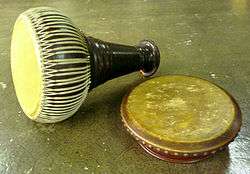Pi (instrument)
Pi (Thai: ปี่, pronounced [pìː]) is the generic term for any of a variety of quadruple reed oboes used in the traditional music of Thailand. It is very similar in construction and playing technique to the Cambodian sralai.
Varieties
- Pi chawa (ปี่ชวา)
- Pi klang (ปี่กลาง)
- Pi mon (ปี่มอญ)
- Pi nai (ปี่ใน)
- Pi nok (ปี่นอก)
- Pi chanai (ปี่ไฉน)
An entirely different instrument, a bamboo free reed pipe called pi chum (ปี่จุม), is used by the Lanna of Northern Thailand.
Pi nok
The pi nok is smallest among pi nok, klang, and nai. Pi noks have been played since the ancient times.
Pi nai
The pi nai (41–42×4.5 cm) is commonly seen in Thai literature such as Phra Aphai Mani.
Pi cha nai
The pi chanai is pi song thon (ปี่สองท่อน, pi that consists of two parts). Body part is called lao pi (เลาปี่). Mouth part is called "lamphong" (ลำโพง). Both parts are made from wood or ivory. It is presumed that the Thais obtained this musical influence from India due to its similarity to the Indian shehnai. Pi have been used in Thai since the Sukhothai period. At present, it is played together with the pi chawa in parades.
Pi chawa
The pi chawa is pi song thon (ปี่สองท่อน) (pi that consist of two parts) like the pi chanai, but longer. It is made from wood or ivory. Presume Thai take in pi chawa as same time as glong khaek. From some evidence, they used pi chawa in Krabuan Phayuhayattra (กระบวนพยุหยาตรา, military march) in the pre-Ayutthaya period.
Pi mon
The pi mon is pi song thon (ปี่สองท่อน, pi that consist of two parts) like pi chawa but greater. Lao pi (เลาปี่, the body of pi) is made from wood. Lamphong (ลำโพง, the mouth of pi) is made from metal. The pi mon is played usually in the piphat mon ensemble or in the old called pi phat raman ensemble. [1] [2] [3] [4]
